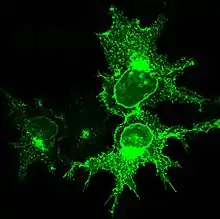| KIAA0319 | |||||||||||||||||||||||||||||||
|---|---|---|---|---|---|---|---|---|---|---|---|---|---|---|---|---|---|---|---|---|---|---|---|---|---|---|---|---|---|---|---|
| |||||||||||||||||||||||||||||||
| Identifiers | |||||||||||||||||||||||||||||||
| Aliases | KIAA0319, DYLX2, DYX2, NMIG, AAVR | ||||||||||||||||||||||||||||||
| External IDs | OMIM: 609269 MGI: 3036268 HomoloGene: 8878 GeneCards: KIAA0319 | ||||||||||||||||||||||||||||||
| |||||||||||||||||||||||||||||||
| |||||||||||||||||||||||||||||||
| |||||||||||||||||||||||||||||||
| |||||||||||||||||||||||||||||||
| Wikidata | |||||||||||||||||||||||||||||||
| |||||||||||||||||||||||||||||||
Dyslexia-associated protein KIAA0319 is a protein which in humans is encoded by the KIAA0319 gene.[5][6]
Clinical significance
Variants of the KIAA0319 gene have been associated with developmental dyslexia.[7][8] Reading disability, or dyslexia, is a major social, educational and mental health problem. In spite of average intelligence and adequate educational opportunities, 5 to 10% of school children have substantial reading deficits. Twin and family studies have shown a substantial genetic component to this disorder, with heritable variation estimated at 50 to 70%.[5]
Mutations in the gene also more generally appear to play a key role in specific language impairment (SLI).[9][10]
Function

The KIAA0319 protein is expressed on the cell membrane and may be involved in neuronal migration. Furthermore, KIAA0319 follows a clathrin-mediated endocytic pathway.[11]
References
- 1 2 3 GRCh38: Ensembl release 89: ENSG00000137261 - Ensembl, May 2017
- 1 2 3 GRCm38: Ensembl release 89: ENSMUSG00000006711 - Ensembl, May 2017
- ↑ "Human PubMed Reference:". National Center for Biotechnology Information, U.S. National Library of Medicine.
- ↑ "Mouse PubMed Reference:". National Center for Biotechnology Information, U.S. National Library of Medicine.
- 1 2 "Entrez Gene: KIAA0319 KIAA0319".
- ↑ Nagase T, Ishikawa K, Nakajima D, Ohira M, Seki N, Miyajima N, Tanaka A, Kotani H, Nomura N, Ohara O (April 1997). "Prediction of the coding sequences of unidentified human genes. VII. The complete sequences of 100 new cDNA clones from brain which can code for large proteins in vitro". DNA Research. 4 (2): 141–50. doi:10.1093/dnares/4.2.141. PMID 9205841.
- ↑ Cope N, Harold D, Hill G, Moskvina V, Stevenson J, Holmans P, Owen MJ, O'Donovan MC, Williams J (April 2005). "Strong evidence that KIAA0319 on chromosome 6p is a susceptibility gene for developmental dyslexia". American Journal of Human Genetics. 76 (4): 581–91. doi:10.1086/429131. PMC 1199296. PMID 15717286.
- ↑ Paracchini S, Thomas A, Castro S, Lai C, Paramasivam M, Wang Y, et al. (May 2006). "The chromosome 6p22 haplotype associated with dyslexia reduces the expression of KIAA0319, a novel gene involved in neuronal migration". Human Molecular Genetics. 15 (10): 1659–66. doi:10.1093/hmg/ddl089. hdl:11858/00-001M-0000-0012-C979-F. PMID 16600991.
- ↑ Rice ML, Smith SD, Gayán J (December 2009). "Convergent genetic linkage and associations to language, speech and reading measures in families of probands with Specific Language Impairment". Journal of Neurodevelopmental Disorders. 1 (4): 264–82. doi:10.1007/s11689-009-9031-x. PMC 2788915. PMID 19997522.
- ↑ Gibson CJ, Gruen JR (2008). "The human lexinome: genes of language and reading". Journal of Communication Disorders. 41 (5): 409–20. doi:10.1016/j.jcomdis.2008.03.003. PMC 2488410. PMID 18466916.
- ↑ Levecque C, Velayos-Baeza A, Holloway ZG, Monaco AP (July 2009). "The dyslexia-associated protein KIAA0319 interacts with adaptor protein 2 and follows the classical clathrin-mediated endocytosis pathway". American Journal of Physiology. Cell Physiology. 297 (1): C160-8. doi:10.1152/ajpcell.00630.2008. PMC 2711651. PMID 19419997.
Further reading
- Ozçelik T, Porteus MH, Rubenstein JL, Francke U (August 1992). "DLX2 (TES1), a homeobox gene of the Distal-less family, assigned to conserved regions on human and mouse chromosomes 2". Genomics. 13 (4): 1157–61. doi:10.1016/0888-7543(92)90031-M. PMID 1354641.
- Cardon LR, Smith SD, Fulker DW, Kimberling WJ, Pennington BF, DeFries JC (October 1994). "Quantitative trait locus for reading disability on chromosome 6". Science. 266 (5183): 276–9. Bibcode:1994Sci...266..276C. doi:10.1126/science.7939663. PMID 7939663.
- Gayán J, Smith SD, Cherny SS, Cardon LR, Fulker DW, Brower AM, Olson RK, Pennington BF, DeFries JC (January 1999). "Quantitative-trait locus for specific language and reading deficits on chromosome 6p". American Journal of Human Genetics. 64 (1): 157–64. doi:10.1086/302191. PMC 1377713. PMID 9915954.
- Nakayama M, Kikuno R, Ohara O (November 2002). "Protein-protein interactions between large proteins: two-hybrid screening using a functionally classified library composed of long cDNAs". Genome Research. 12 (11): 1773–84. doi:10.1101/gr.406902. PMC 187542. PMID 12421765.
- Londin ER, Meng H, Gruen JR (June 2003). "A transcription map of the 6p22.3 reading disability locus identifying candidate genes". BMC Genomics. 4 (1): 25. doi:10.1186/1471-2164-4-25. PMC 166143. PMID 12834540.
- Francks C, Paracchini S, Smith SD, Richardson AJ, Scerri TS, Cardon LR, Marlow AJ, MacPhie IL, Walter J, Pennington BF, Fisher SE, Olson RK, DeFries JC, Stein JF, Monaco AP (December 2004). "A 77-kilobase region of chromosome 6p22.2 is associated with dyslexia in families from the United Kingdom and from the United States". American Journal of Human Genetics. 75 (6): 1046–58. doi:10.1086/426404. PMC 1182140. PMID 15514892.
- Luciano M, Lind PA, Duffy DL, Castles A, Wright MJ, Montgomery GW, Martin NG, Bates TC (October 2007). "A haplotype spanning KIAA0319 and TTRAP is associated with normal variation in reading and spelling ability". Biological Psychiatry. 62 (7): 811–7. doi:10.1016/j.biopsych.2007.03.007. PMID 17597587. S2CID 11334660.
- Velayos-Baeza A, Toma C, da Roza S, Paracchini S, Monaco AP (September 2007). "Alternative splicing in the dyslexia-associated gene KIAA0319". Mammalian Genome. 18 (9): 627–34. doi:10.1007/s00335-007-9051-3. PMID 17846832. S2CID 42549021.



